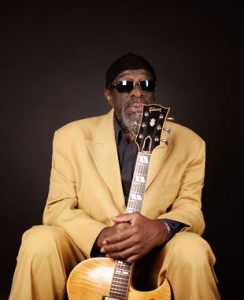Freefunkjazzblues van de meester
“Jazz is the teacher, funk is the preacher” is het motto van de Amerikaanse jazz, freefunk en bluesgitarist/zanger James Blood Ulmer. Hij wordt binnenkort 75 jaar, en je kunt rustig zeggen dat hij een legende is.
“… the missing link between Jimi Hendrix and Wes Montgomery on one hand, between P-Funk and Mississippi Fred McDowell on the other”, schreef Greg Tate eens in de Village Voice.
Dit keer speelt hij in Nederland met het trio dat afgelopen zomer in New York iedereen omver blies op het toonaangevende Vision Festival. Samen met een explosieve ritmesectie bestaande uit bassist Calvin Jones en drummer Aubrey Dayle.
donderdag 15-1 Bimhuis Amsterdam, vrijdag 16-1 LantarenVenster Rotterdam
In de freejazz vond je nooit erg veel opvallende gitaristen. Op één na: James Blood Ulmer. Meestal baseren gitaristen zich op idolen en voorbeelden uit de geschiedenis van de rock-gitaar. James “Blood” Ulmer is een van de weinige uitzonderingen, hij baseerde zijn stijl grotendeels op de tradities van de Afro-Amerikaanse blues, jazz en soul. Al sinds zijn doorbraak in de jaren zeventig staat Ulmer bekend als vernieuwer van de elektrische gitaar.
Sound en spel van Jimi Hendrix zijn evenwel toch ook bij JBU terug te horen, maar vermengd met blues, funk, en free jazz-elementen. Zijn muziek was en is altijd expressief, rauw, vaak scherp en hard, en altijd met een rafeltje.
Zijn bands zijn soms meer gericht op freejazz, dan weer blues, dan weer freefunk.
Jazz is the teacher, funk is the preacher
Vanaf 1971 werkte JBU in New York met o.a. Art Blakey’s Jazz Messengers, Paul Bley, Rashied Ali en Larry Young. En ook met saxofonist Ornette Coleman in de extreme funk van diens groep Prime Time. Coleman had grote invloed op hem.
Ulmer werd een aanhanger van de vaag omschreven Harmolodic theorie van Ornette Coleman, die de jazz-harmonieën in feite afwees, ten gunste van een vrij geïmproviseerde, niet-tonale, of quasi-modale aanpak.
JBU stemt zijn gitaar (gitaren) anders dan in de standaardstemming:in A of E.
Dat wil zeggen: alle snaren zijn zo gestemd, dat er bij het aanslaan van de losse snaren een A of E akkoord klinkt. Daardoor klinkt het onmiddellijk heel bluesy…
Hieronder uitgelegd in de video: James Blood Ulmer answers two questions: what are you doing on your guitar and how is your guitar tuned?
Hij speelde in vele bezettingen, bijvoorbeeld free jazz met de groep Phalanx (met George Adams – tenorsax, Amin Ali – bass,Grant Calvin Weston – drums)
https://www.youtube.com/watch?v=IqxSR7Z3ldI
Later in de jaren 80 en 90 werd zijn muziek minder ‘free’: meer struktuur, duidelijker ritmes, minder onvoorspelbaar. Hoewel The Music Revelation Ensemble (opgericht in 1980) toch nog steeds wel invloeden uit de freejazz liet horen. In die band speelde ook saxofonist David Murray (althans de eerste 10 jaar) en later de saxofonisten Sam Rivers, Pharoah Sanders en John Zorn.
Ook speelt hij veel met gitarist Vernon Reid.
https://www.youtube.com/watch?v=JEzdRX36VRM
Heel concert uit 2003, met tenorsaxofonist Pharoah Sanders erbij
ENGLISH
Free funk jazz blues from the master
‘Jazz is the teacher, funk is the preacher’ is the motto of American jazz, free funk and blues guitarist/singer James Blood Ulmer. He will soon turn 75 years and may now certainly be called a legend. “… The missing link between Jimi Hendrix and Wes Montgomery on one hand, between P-Funk and Mississippi Fred McDowell on the other”, Greg Tate once wrote in the Village Voice
This week JBU plays in the Netherlands with the trio that blew everyone down last summer in New York, on the leading Vision Festival. Together with an explosive rhythm section consisting of bassist Calvin Jones and drummer Aubrey Dayle.
Thursday 15-1 Bimhuis Amsterdam, Friday 16-1 LantarenVenster Rotterdam
 (photo Julia Wesely)
(photo Julia Wesely)
There never were very prominent guitarists to be found in free jazz. Except for one: James Blood Ulmer. Usually guitarists rely on idols and examples from the history of rock guitar. James “Blood” Ulmer is one of the few exceptions, he based his style largely on the traditions of the African-American blues, jazz and soul. Since his breakthrough in the seventies Ulmer is known as an innovator of the electric guitar. However, Jimi Hendrix sound and playing are nevertheless also be heard with JBU, but he combines it with blues, funk and free jazz elements.
His music was and is always expressive, raw, often sharp and loud and jagged. His bands sometimes focused on free jazz, sometimes blues, sometimes free funk.
From 1971 JBU worked in New York with ao Art Blakey’s Jazz Messengers, Paul Bley, Rasheed Ali and Larry Young. Also with saxophonist Ornette Coleman: the extreme funk of his group Prime Time. Coleman had a great influence on him. Ulmer became a supporter of the Ornette Coleman theory of Harmolodics, who in fact rejected the jazz harmonies in favor of a freely improvised, non-tonal, or quasi-modal approach.
JBU tunes his guitar(s) in A or E, different from the standard tuning. That is, all strings are tuned in such a way that when you strike the open strings, an A or E chord sounds. As a result it sounds very bluesy … In the video above explains James Blood Ulmer answers two questions: what are you doing on your guitar and how is your guitar tuned?
He played with many different bands, such as free jazz with the group Phalanx (with George Adams – tenor sax, Amin Ali – bass, Grant Calvin Weston – drums). Later on in the 80s and 90s, his music became less “free”: more structure, defined rhythms, less unpredictable. The Music Revelation Ensemble (founded in 1980) yet still contained influences from free jazz. In that band saxophonist David Murray also played (at least the first 10 years) and later the saxophonists Sam Rivers, Pharoah Sanders and John Zorn. JBU also plays with guitarist Vernon Reid.